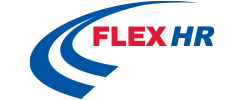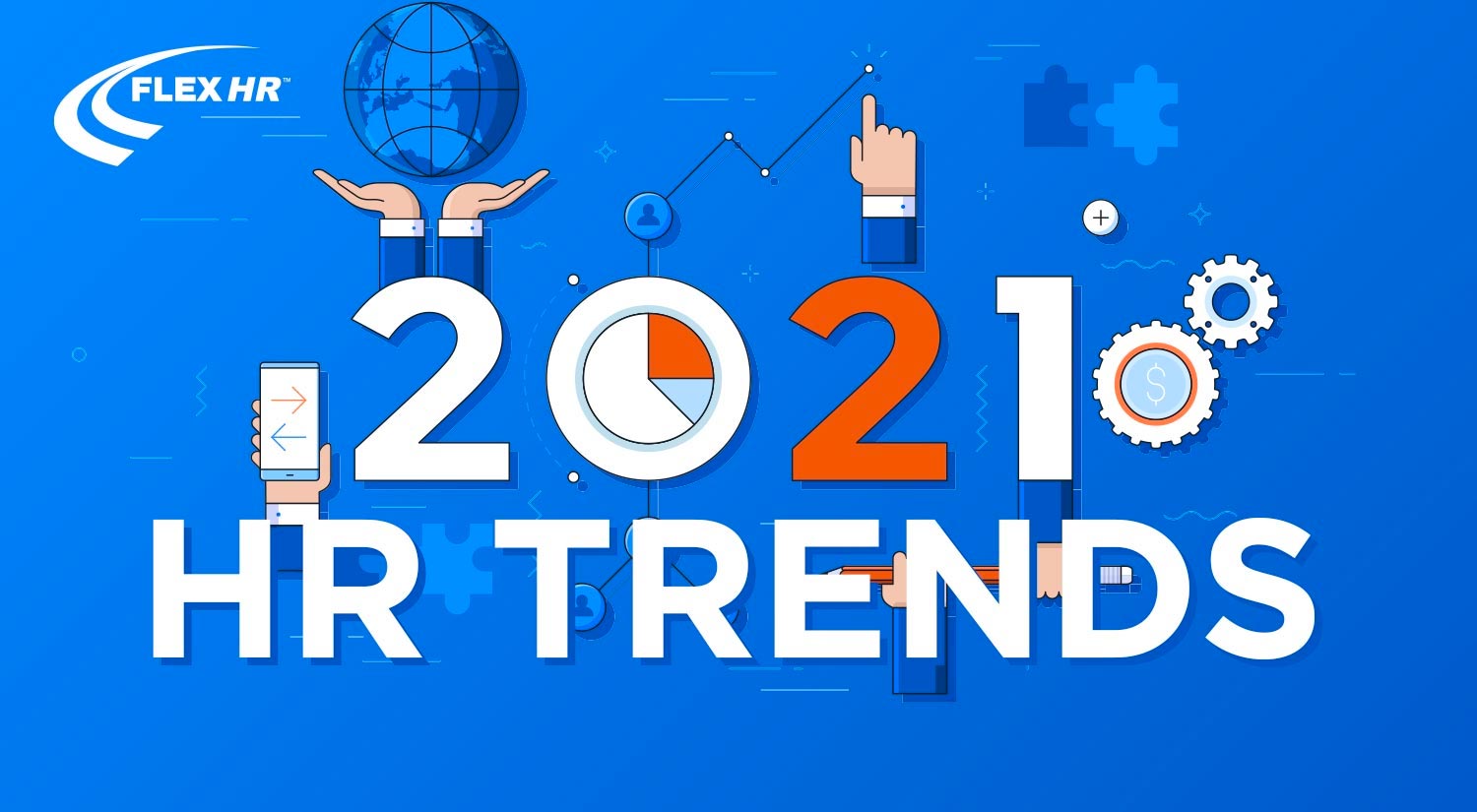2021 Top 7 Human Resources Trends
Well, we all know 2020 was quite the challenging year for so many businesses throughout the nation as the Coronavirus pandemic unwelcomely inundated routine working operations. Organizations were radically forced to spotlight their HR department to guide environmental changes and navigate functioning processes, prioritizing workforce concerns. 2021 is starting off a bit unpredictable; plausible given the circumstances that last year unveiled and there is no going back to “normal.” This year we are sure to endure more ongoing transitions as companies continue to adapt to their current dynamic surroundings.
Therefore, it’s crucial for Human Resource professionals, like Flex HR, to evaluate what’s working for a company, and what’s not in these times, to make compliant alterations now. What does this mean as we settle into the new year? Flex HR predicts their top HR trends that will shape 2021:
- Outsourcing Human Resources is on the rise
- Working from home continues
- Hiring and training new employees remains challenging
- Focus on employees’ well-being and mental health
- New state and local laws advance
- Ethical leadership prominence
- Immigration concerns
#1: Outsourcing Human Resources is on the rise
We hear time and time again that business owners spend so much time and energy sorting out their human resources. That’s no surprise with HR’s evolving complexities – especially in a pandemic. Thus, business leaders are opting for HR Administrative Services Organizations (ASO) and Human Resources Outsourcing (HRO) to focus on their core work and increase productivity knowing their HR functions are in trusting hands. HR outsourcing has become an essential part of small to mid-sized companies especially, while overall, the demand is steadily rising. Today nearly 85% of organizations outsource at least some HR functions* to firms like Flex HR, strengthening employment law compliance, updating operating models, improving company policies and cultures, improving productivity, and saving money.
#2: Working from home continues
It’s hard to believe that COVID-19 hit the US a year ago, yet the health crisis lingers on and it’s evident that the majority of businesses are continuing to have their staff work from home (WFH). Companies all over have had to adapt to new digital working environments.
Hybrid working models are also becoming more popular, where a certain number of employees come into the office while others work from home and then switch.
HR leaders need to take a look at their current policies that are in place and finally put plans into writing, if they haven’t done so already.
Back in March 2020 when the COVID crisis heightened, most organizations released their employees to go work from home during such a disorderly and unknowing time. However, now employers are realizing they did so without policies in place and the question becomes now what do we do? It is time to address those tough questions that have come about and put them into actual policy items within the company handbook such as:
- How does an employee secure the internet connection?
- What about data breaches of passing confidential information on unsecure networks?
- What if there is confidential information sitting on kitchen tables that are not secure for others to see?
- How do we accommodate shredding needs?
- How do we handle printing and faxing needs?
- Who pays for what while the employee is working from home using their own equipment?
- How can we be sure our employees stay productive?
- What kind of mental health check-in measures are needed?
Organizations need to consider what employees really want, and if remote productivity has been succeeding, with what the business really needs in order to prosper. Once these considerations are determined, next is the decision to bring folks back to work in the office. Businesses now need to firm up WFH policies to tighten up their operations regardless. Strategic planning is needed immediately to establish the right course of action.
#3: Hiring and training new employees remains challenging
Despite the fact that some businesses have unfortunately had to let some of their staff go or close their doors altogether, many companies are hiring for new positions more than ever. However, hiring during a pandemic presents its own set of challenges and has been difficult to accomplish, especially now doing so remotely. While the talent pool seems to be hefty, so does the work of recruiters to find candidates that measure up to what the company is specifically looking for.
Once the right individual is offered the job, onboarding processes need to run smoothly in order to ensure the new hire feels comfortable and confident beginning a new endeavor unaccompanied. HR needs to consider pacing new hire paperwork and training initiatives for building rapport and engagement, so as not to overwhelm newcomers. Short 5–8-minute training videos spaced out over time, or days, has been shown to be effective for the new hire to absorb the information sufficiently.
The majority of the new employees hired within the past year have not even seen inside the office. You may want to consider taking a quick video to show the new employees what your office looks like so they can get a feel for the company and culture.
Employers should also create time for virtual social interaction to encourage team building and collaboration between co-workers so that company culture remains integral. At Flex HR, CEO Jenny Morehead has scheduled Zoom coffee breaks every other week to interact with staff to welcome new employees, celebrate client and employee wins and gather from afar to check in with each other. “The company morale and encouragement since beginning our virtual coffee breaks together has really seemed to increase and lift the essence of those relationships in our office,” notes Morehead.
#4: Focus on employees’ well-being and mental health
The pandemic has certainly given employers and business leaders increased visibility into the personal lives of employees over the past year. The struggles of working from home and added stress factors such as childcare, caregivers, financial issues, and other health concerns have now been exposed. Flex HR has seen the unfortunate upswing in depression our clients’ staff as well as an increase in employees under the influence of alcohol and drugs. “We’re seeing a shift in how employers view among mental health in the workplace,” says Julie Gurican, senior director of people at BenchPrep. “It is no longer a binary category where you either have a mental illness or you don’t. HR leaders will need to continue to lean on normalizing mental health in the workforce and ensure employees know ‘it’s ok’ to ‘not always be ok’ at work.”
This serious decline in employees’ mental health makes it imperative that employers be empathetic and take action to help their workforce immediately. HR specialists have not surprisingly acknowledged that their staff’s anxieties have resulted in a major decrease in productivity, engagement and motivation. According to the latest Mental Health Index: U.S. Worker Edition from Total Brain, there was a 48% increase in the risk of depression—a risk level not seen since this past spring. Further, employees’ focus dropped 62%—a record low since the inception of the research in February 2020. Jim Cichanski, CHRO of Flex HR explains “there are two different extents to this. First are those that have been working at home now feeling alone, depressed and in need of social interaction and activity. The second are those reporting to their workplace every day, such as essential workers, having to wear masks up to 12 hours a day and feeling more claustrophobic while getting more and more depressed as these long days keep repeating themselves.”
Supporting employees work / life balance will be of utmost importance throughout this year in order to connect and retain individuals. Employers are already starting to build better communication check-in outlets and expand mental health benefits such as creating days where they shut down the entire company to offer “a collective mental health day” to help address this issue.
#5: New state and local laws advance
Altering employment laws will continue throughout the year with some of the most prominent trends happening at the state and local level. These include creating or expanding paid leave benefits, pay equity, and anti-discrimination rules; restricting criminal background checks; and limiting the scope of non-compete laws. Some states are now easing up on certain COVID restrictions, such as reducing the firm requirement of party size and social distancing to allow the economy to move forward. Employers are depending on their HR professional to assess these developments and update their company policies and procedures accordingly.
Meanwhile, the Federal government is considering putting close to two trillion additional dollars to support COVID relief and tiering this at many different levels. Another topic on the horizon we should see shortly is increased Unemployment coverage, in addition to extensions to the Family First Act payments.
#6: Focus on diversity, equity and inclusion (DEI) efforts
The coronavirus has put a new spotlight on creating a diverse, equitable, and inclusive workforce as the societal role of employers is cultivating. Companies have really come out of their woodwork to speak up against racism to push for more education and change.
The business case for diversity and inclusion is stronger than ever as McKinsey research shows the most diverse companies are more likely to outperform less diverse peers on profitability.
Employers across the nation are promoting diversity, equity and inclusion (DEI) by taking action to encourage training programs and growing diversity throughout their employee and leadership ranks, fostering inclusion and belonging, and preventing both subtle and egregious acts of discrimination and harassment. To safeguard against such DEI and bias, HR authorities suggest outlining policies and practices to warrant inclusive recruitment, hiring, development, and compensation to create a comprehensive workplace.
#7: Immigration concerns
Yet another challenge that lingers into 2021 is the concern over immigration work VISAs that have been expired. According to Mitratech Holdings, Inc, the number of immigrant visas granted by the U.S. in 2020 dropped 46%. Pre-pandemic, new applications for green cards decreased by 17% in the Trump years, and immigrant visas issued fell by the same amount.
Employers have had to make significant changes in order to remain compliant with evolving regulations.
Since the start of the pandemic Trump’s administration has issued over 48 policy alterations impacting nearly every facet of the immigration system. The H-1B visa system, which allows American employers to temporarily employ foreign workers in specialty occupations, has been under constant modification.
Recently, the US announced that it is changing the selection process for the H-1B visa to prioritize salary and skills over the current lottery system. The U.S. Citizenship Act of 2021 would also attempt to resolve the employment-based visa backlog, eliminate per-country visa caps for green cards, codify work authorization for the spouses of H-1B visa holders, incentivize higher wages for H-1B workers so as not to displace U.S. workers and encourage ways to improve the employment verification process.
All of these actions are very new, so we will not see the end results of these actions for many months to come. We expect to see additional lifting of employee friendly rules and regulations to occur.
So now that we have outlined our top seven HR trends of 2021, you can see how crucial it is for HR leaders to continue monitoring big changes and staying ahead of predicted challenges. This will be another year of transitions and it’s time to start facing these trials head on as we settle into this new normal.
* “Outsourcing HR: Big Savings for Small Business,” by Adam Skolnick, The Fiscal Times.
Flex HR, Inc. is among the top HR outsourcing and consulting firms, based out of the Atlanta, GA area. They were selected Best of Johns Creek Award in the Business Human Resources Consultant category by the Johns Creek Award Program last year, and this year was inducted into the Johns Creek Business Hall of Fame. The Atlanta Journal-Constitution awarded Flex HR “Best of Atlanta Business Profiles” while Outsourcing Gazette magazine listed Flex HR as the “Top Most Promising HR & Staffing Service Vendors.” For 3 years INC Magazine recognized Flex HR as an Inc 5000 “Fastest Growing Privately Held Companies in America”. Jim was also recognized by the North Fulton Chamber of Commerce as the “Small Businessperson of the Year.” Catalyst Magazine acknowledged Flex HR as 1 of 18 Companies CEO’s in Atlanta would like to own.
Visit our Coronavirus pandemic page or more information on how businesses are managing their HR assets during the continued consequences of COVID-19.
Want a webinar for your business or more information? CONTACT US NOW



